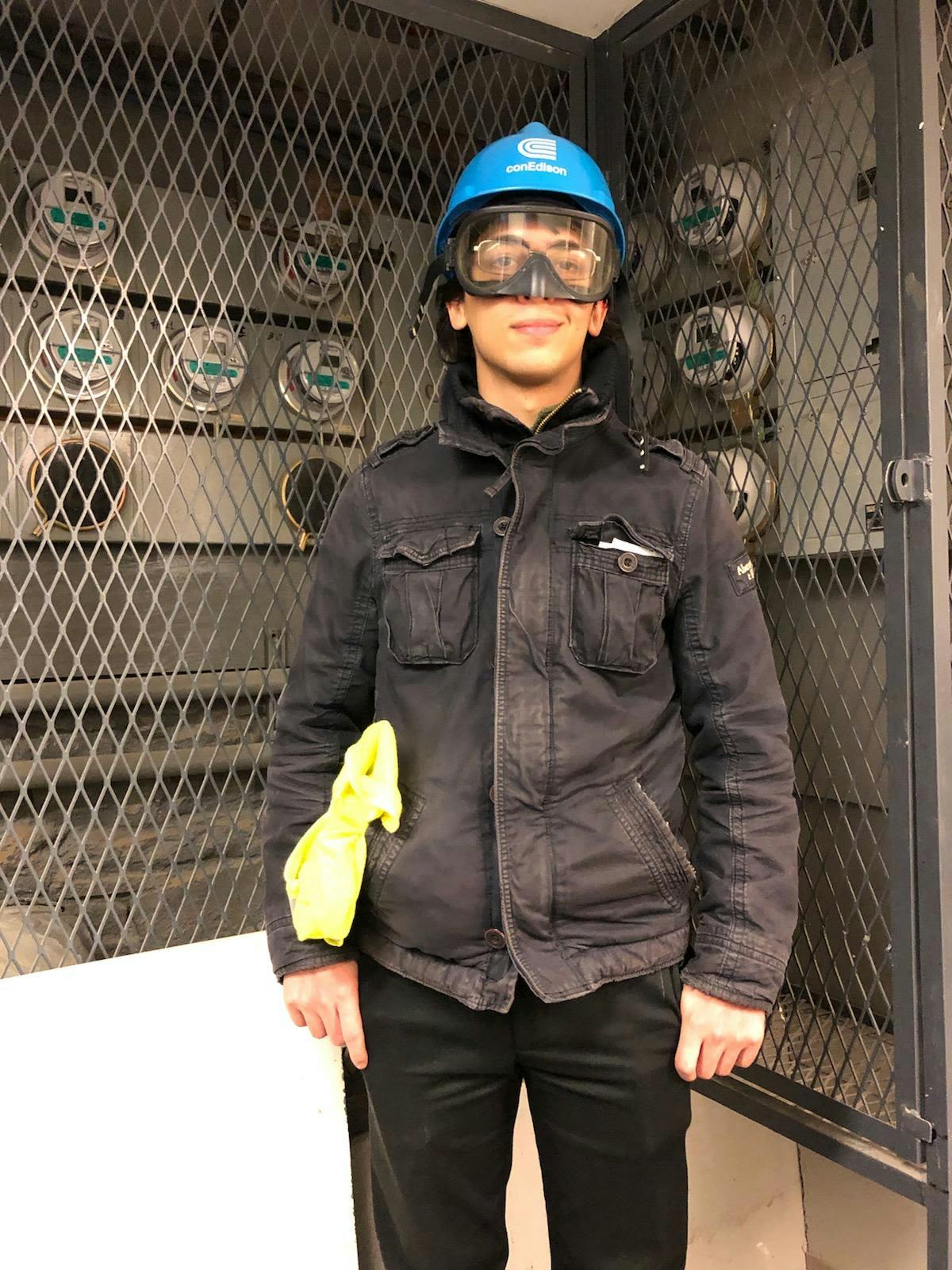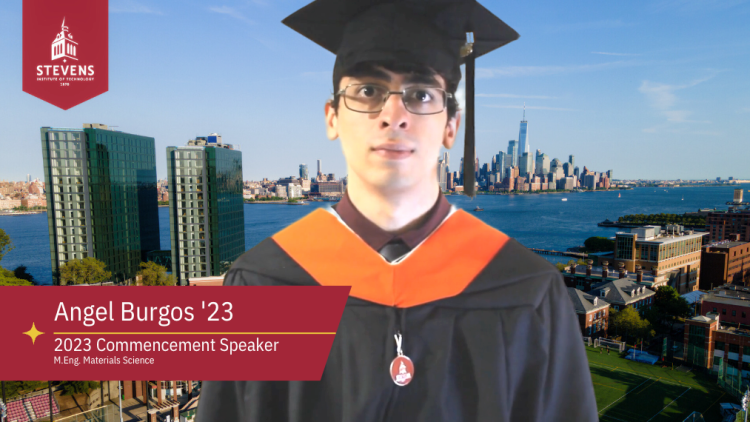Materials Science and Engineering Student Earns Top Graduate School Spots After an Illustrious Career at Stevens
Angel Burgos took advantage of all Stevens had to offer to bring him closer to his dream of a more sustainable future
Stevens Institute of Technology Chemical Engineering and Materials Science student Angel Burgos has always known that he wanted to play a role in changing the world for the better — and that he’d use engineering to get there. During his time at Stevens, Burgos pursued multiple pathways to make his dream a reality, from university extracurriculars to summer research and learning opportunities.
All of Burgos’s hard work earned him spots in some of the most competitive Ph.D. programs in the nation. He was accepted to Columbia University in New York City; Georgia Institute of Technology in Atlanta, Georgia; and Stanford University in Stanford, California. He has chosen to attend Stanford, paving the way for him to get the academic platform he wants to make a difference in the world.
Burgos cited his grandfather, an engineer from Colombia, as being the person who showed him that knowledge is more than just for advancing one's career and self, but for creating impact in the world around you. “He taught me how technology can really change the world for the better. Unfortunately for the worse, too, in terms of things like emissions. But there's ways that you can really shape society and culture.”
For Burgos, the big issue he wanted to tackle was climate change. “After high school I came to Stevens to do my undergraduate in chemical engineering; and I hadn't exactly figured out how, but I knew in some way I wanted to reduce emissions, help mitigate climate change in some way.”
“I think Stevens has helped a lot by giving me the opportunities to engage in so many different jobs and extracurriculars, where I can really get a feel for where I fit in.”
Using work experience to align theory and practice
One of the programs Burgos took advantage of was the Cooperative Education Program. Burgos was able to complete two co-op placements during his time at Stevens.
The first was at energy company Con Edison, where he was an engineering aid intern. There he filed reports and explored new programming languages such as SQL.
Burgos enjoyed the mentoring component of his time at Con Edison. He was there for multiple intern cycles and helped onboard the interns who joined in the summer. “That was just a really cool experience,” said Burgos, “One of the memorable things was, one of the managers that we worked with had said that we ended up becoming one of the most productive groups of interns he's ever seen.”
For his second co-op, Burgos worked at the oil industry company British Petroleum (BP) as an assistant researcher in research and development (R&D) for new motor oil additives. While an oil industry co-op might seem counterintuitive for a student passionate about sustainability, Burgos believed in the work that he was doing. “You're still improving the efficiency of the engine so that it's using less gas to push more power through,” explained Burgos.
Additionally, Burgos was excited for his job at BP because of the research opportunities it offered him. “I ended up doing my own project where I was studying a new motor oil blend and testing it out over time to see how its properties would change,” said Burgos. “So, for example, you sell some motor oil. If it stays on the shelf for a couple of months, and then you sell it, is it still going to perform just as well? Is it going to look the same? You really make the connection between what in theory is going to work, and how we apply that in practice and show that in the real world.”
The job was a mix of wet lab work and computational analysis. Burgos found the workflow exciting. He was also inspired by his co-workers. “Everyone there were Ph.D. researchers,” said Burgos. “I had all these really smart people to interact with, and they could help guide me, and help me not only figure out how to get [my project] to work, but also understand at a deeper level, ‘What's going on? What's happening in this material that makes your motor oil more viscous?’, and so forth. I think that kind of collaboration with really smart people was really fun.”
A love for research continues to blossom
Burgos left BP fully bitten by the research bug and began looking for someone he could do research with at Stevens. His first thought was Professor Jae Chul Kim. Burgos had taken a thermodynamics class with Kim in a previous semester and remembered that Kim’s research focused on batteries.
Said Burgos, “Through my general interest in sustainability, I already knew how big of a part batteries can play in transitioning towards more renewable energies, like getting off of gasoline for your electric vehicles, or allowing solar to work at a grid scale level.”
Burgos connected with Kim and was able to perform research with him and his graduate students through the Innovation and Entrepreneurship (I&E) summer research program. For that first summer, Burgos and graduate student Junteng Du researched solid-state batteries: batteries that have had the flammable liquid that allows for lithium ion flow replaced with a solid material option. These batteries are safer because solids are less reactive than liquids, but issues remain with getting them to function as consistently as traditional batteries.
“The big thing with battery materials is, you want them all to have really close contact, and that's easy with a liquid. It'll wrap around your particles, and it'll contact it with itself,” explained Burgos. “But with a solid, you need to have a really flush surface connection between the two of them. It's been a big issue trying to get our cathode materials to make good contact there.”
Initially Burgos’s research quantified the lifespan difference between a solid-state and a liquid battery. He was then able to help Du with his work examining a ceramic additive to their solid material that helped with conduction.
“It was really fun learning a lot about the battery research at a higher level,” said Burgos. “The other fun part was just being able to talk about it and communicate, ‘Okay, I did all this work. Here's why anybody should care about it.’”
A future in academics
Burgos’s summer research earned him first place in the I&E poster competition and second place in the I&E elevator pitch competition. It cemented to Burgos that he wanted a career in research, and led him to more seriously plan an academic career. He was accepted into the Accelerated Master’s Program (AMP) for the 2022-23 academic year, where he has worked as a course assistant and continued his research with Kim.
For one of his course assistant roles, Burgos is a design facilitator for undergraduate engineering class Design with Materials. “I’m guiding them in group projects and helping them understand, ‘Okay, here's a problem. How can we use materials to make things a little bit more sustainable, or reduce plastic pollution, or make something that's more biodegradable or easier to recycle,” explained Burgos. “I think that has been a really great experience, being able to engage with students and inspire them.”
His independent project in Kim’s lab focuses on batteries that use lithium iron phosphate as their cathode material. The cathode is the part of the battery that charged ions flow toward to transfer electricity. Lithium iron phosphate cathodes are typically shown to be safer than other cathode materials because they release less volatile oxygen, but they don't store as much energy as some other commercial cathodes do. Burgos has experimented with replacing the iron in the cathode with manganese and adding a conductive layer within the battery that helps with ion flow.
Burgos’s research has direct ties to his sustainability goals. “We've shown experimentally that with this coating layer, you can discharge your battery really fast and get more energy out of it at the same time. And that could be definitely practical for things like electric vehicles, where, if you want to hit the gas, you need it to discharge fast enough and give you that power.”
Burgos began applying to Ph.D. programs while in AMP, and while initially planning to apply to ten schools, stopped applying after he was accepted into his dream program at Stanford. He will start his graduate studies there in the Fall of 2023. He believes that the academic track is the best way for him to make a difference in the world in the field of climate change because having his own research group would give him diversification and flexibility in what he researches.
Burgos credits Stevens with helping find and align his goals with this dream. “I think Stevens gave me the opportunity to have those experiences that I might not have had otherwise. And that was really great.” His pursuits at Stevens “opened my eyes and helped me find a path that I think was suited for me.”


